Triang Minic Slot Cars
| Slotcar systems |
|---|
| Minic Motorways |
| 1960s - |
| Airfix/MRRC | Champion | Circuit 24 | Cox Slot Racers | Formula 152 | Highways | Matchbox Motorway | Minic Motorways | Monogram | Revell Model Racer | Scale Raceway Models (SRM) | Scalextric | VIP Raceways |
Tri-ang's Minic Motorways slotcar system appeared in the early on 1960s. A critical distinguishing feature of the system to near alternatives was that it was designed to 1:76 scale, for interoperability with the company's successful Tri-ang Railways range. While well-nigh slotcar systems were designed and marketed every bit toy racetracks, the Minic Motorways system was designed to allow model railway layouts to contain moving route traffic, and around more than model-railway-like design sensibilities.
Early on advertising was absolutely rough, and seemed to marketplace the system as an exciting way of having a barebones model railway loop and grey slotcar route loop intersecting, with the constant danger of having your car hit past a freight train (unless yous were careful). Withal, the system speedily expanded, with clip-on pavements and grass verges assuasive it to coexist more than politely with "proper" model railway layouts, and with level crossings and "intersection logic" to prevent cars and trains hitting each other. One could lookout man the surreal sight of cars approaching a level crossing, and apparently seeing the approaching train and pausing until it was safe to cantankerous, then continuing. This gave a layout's behaviour a far greater sense of sophistication – one could well-nigh imagine the little drivers within the cars tut-tutting as they waited for the train to pass earlier impatiently scooting off again.
Promotional text
Off to a Racing Kickoff ... and Alee in Every Management, with Tri-ang MINIC Motorways
Every Minic Motorways Fix holds the promise of a young lifetime of pride and pleasance in building the earth'due south finest 00 scale state highway organisation. As you will encounter in the ensuing pages a wide diversity of tough rails sections clip speedily and firmly together without the aid of tools or locking devices.
Racing circuits of any size and contour can hands be assembled ready for dashing sports cars to fight their exciting way to the chequered flag.
Beautifully detailed cars and commercial vehicles can be driven at varying speeds forward and in reverse – simply like the real thing!
Build in your Tri-ang Railways, too! Level crossings, route/rail junctions, the incredible motorcar transporter and loading ramp set a new high standard in fun and authenticity.
In addition, the models of modernistic buildings, which tin be seen on pages xviii and nineteen, volition complete the realism of any chosen layout.
All models are designed to operate from 12/15 colts D.C. (Direct Current). For operating from A.C. mains electricity supply a suitable ability controller having an output of 12/15 volts D.C. is required. For battery functioning a battery container and three 4½ 5. dry batteries are required.
For simplicity, versatility and durability Minic Motorways accept no equal.
Range
The Minic Motorways range expanded again with a range of roadside buildings with "added value" features such as smoking chimneys and automatically opening garage doors, and were supplemented by the Tri-Ang Model-Country range of pre-coloured (merely paintable) plastic kits of buildings and sets of paintable people. Level crossings had flashing beacons, crossroad intersections had mutual cutouts to auto-intermission traffic, some road sections had railway tracks besides, and you could fifty-fifty drive your auto right onto a road or railway auto transporter, or straight onto a motorcar ferry. More than complicated road junctions (including a four-way roundabout) allowed you to switch the default behaviour of a automobile approaching a "fork", to roadway systems with really quite complex paths.
The system was and so promoted as also compatible with the 00-scale sub-range of the Tri-ang Spot-On Arkitex building kits which allowed faithful recreations of 1960s office buildings, and of course, one also had the range of railway station and trackside buildings in the Tri-ang Railways range to play with (it would be natural for a big station or a goodsyard to accept a road aslope).
With the takeover by Tri-ang of Meccano Ltd, and the incorporation of some parts of the Dublo range into the new merged Tri-ang Hornby system, advertizement showed layouts built of a mixture of Minic Motorways and Tri-ang Hornby buildings.
In addition to the racing and "rallying" sets, at that place was also a Holiday Highway set (K.1518), a Crime Patrol gear up (Grand.1519), and a Heliport International set (Grand.1527)
Vehicles
The idea of a realistic combined route and railway layout was reflected in the wide range of vehicles available: While Minic Motorways did include a few sports cars, some in racing colours (and a Police Auto with flashing lights), it also included coaches, double decker buses, lorries, a steam lorry issuing real smoke, and a tank. Given that tank racing wasn't a pop pastime, it was pretty obvious that this wasn't a system designed primarily for racing.
Reinvention
While there were undoubtedly some hobbyists out there who loved the power to utilize these complementary ranges of pre-built and kit scenery to construct their own massive animated cityscapes. Information technology must have occurred to Lines Brothers Ltd that they now had an excessively large range, and that really, what most people bought slotcars for was to brand a uncomplicated effigy-eight rails and race cars against their friends and family members – the slotcar race set up was a archetype family "Christmas tree" toy that immune the whole family unit to spend Boxing Day sitting on the lounge floor and playing racecars. This was not the aforementioned market as the solitary hobbyist diorama constructor.
Minic Motorways had the wrong name. Although the opening of the UK'southward first motorway (the M1) in the late 1950s had lent an air of glamour and zeitgeist to the word "motorway", motorways themselves tended to exist directly and fairly uninteresting creatures, urban cityscapes weren't technically motorways, and someone wanting to buy a slotcar racing set might not be excited by the rather staid "Minic Motorway" branding. The product line just had the incorrect name for the "racetrack" market, and although Lines Brothers had recently bought the significantly larger 1:32-scale Scalextric system to address that market, Minic Motorways also needed to sell into the racing market to maintain "critical mass".
Triang's new advertizement no longer promoted urban realism so much, and full-bodied on racing excitement, and with a respectable range of racetrack accessories (including a Dunlop bridge and various racetrack buildings, and a thorough range of layout designs to emulate famous racetracks), the company started using iii different branding variations: Minic Motorways, Minic Motor Racing, and Minic Rally Racing. However, this more focused sub-branding perchance appeared a little later on than information technology should take, by which time the company was bogged down with trying to merge the Tri-ang and Meccano Ltd ranges, and a few short years later the whole Lines Brothers behemoth went bosom and were bought by the Airfix group.
Slotcar system extinction
These takeovers would have resulted in a rather cool range of different incompatible slotcar systems all "under the aforementioned roof" – Minic Motorways (Tri-ang, in-firm), Scalextric (Tri-ang, bought from Minimodels Ltd), Formula 152 (Wrenn, which Triang had bought a major pale in), Excursion 24 (Meccano Ltd, big in France) and and then Airfix'southward own system Airfix MotorAce / Airfix MRRC (developed by MRRC, which Airfix had taken over).
In the resulting shakedown, Formula 152 disappeared when Triang bought into Wrenn, MRRC were floated off as a separate company, and Minic Motorways became an about inevitable prey of the overabundance of incompatible systems.
The disappearance of so many systems meant that slotcars became again primarily something that you bought at Christmas as a single set, then threw away when something (inevitably) bankrupt. Tragically, the slotcar customs had never standardised on interchangeable parts and accessories as the model railway community had, and although cars could often be modified to run on a different organization'south track, the profusion of incompatible track spacings and connectedness systems made investing serious money in a roadway organisation rather risky. If a company decided to "pull the plug" on a system (as happened to Minic Motorways), yous couldn't merely purchase uniform track (and fencing, etc) from a different manufacturer, and were reliant of the express number of accessory parts already in existence, and on the second-hand market. The large number of almost compatible proprietary formats "split the market", and made it uneconomical for anyone other then the smallest of niche makers to back up other company'due south current or obsolete ranges.
Advertizing
Covers
External links
- Minic Motorway (tri-angrailways.com)
- Dave Angell: My Displays: Minic Motorway (daveangell.co.britain)
- Minic Motorways sets (minicmotorways.weebly.com)
- Triang Minic Motorways, discussion (hornby.com)
Source: https://www.brightontoymuseum.co.uk/index/Category:Minic_Motorways

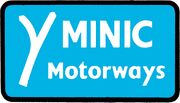
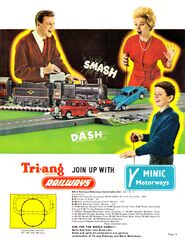
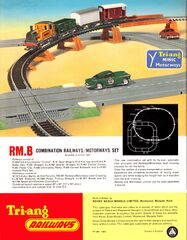
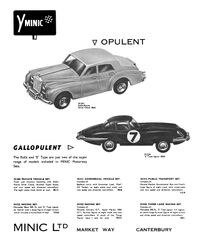
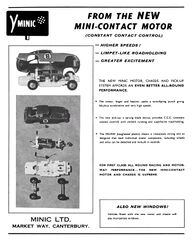
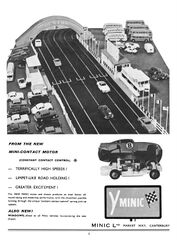
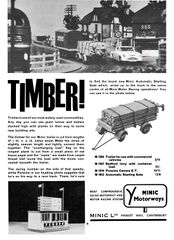
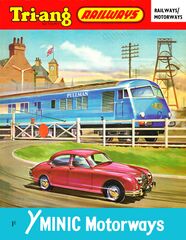
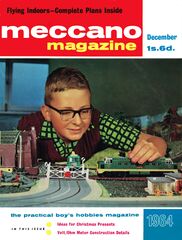
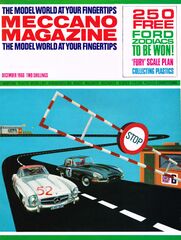
0 Response to "Triang Minic Slot Cars"
Post a Comment